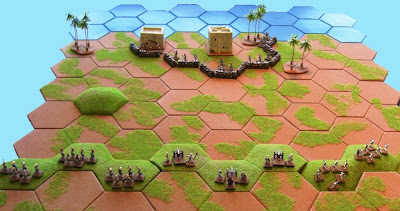The first play-test of REDCOATS AND NATIVES was set in the Sudan during the period before the Siege of Khartoum, when the Egyptians were still trying to extort taxes from the population and the Mahdi’s power was still on the rise.
A column of Egyptian troops (two infantry units, an artillery unit, and a machine gun unit, all rated as ‘Average’) led by Mustafa Pasha was advancing on the small town of El Mhet. The local sheik had recently received representatives from the Mahdi. They had persuaded him to support the Mahdi, and had sent three units of Jihadia infantry and two artillery units (all rated as ‘Average’) – led by Sheik Mehmet Abdullah – to garrison the town. The sheik had no doubts that when the Egyptians (or ‘Turks’ as he preferred to call them) came to collect more taxes – as come they would – he would ambush them and put them all to the sword.


When news of the Egyptian column’s approach reached El Mhet, Sheik Mehmet Abdullah positioned one of his artillery units in a valley to the left of the Egyptian line of advance. From that location it should be able to enfilade the Egyptian column and prevent it from deploying to its left. He positioned the other artillery unit by the town’s fort, which he had garrisoned with one of his infantry units..

The other two infantry units were hidden from view; one was behind a small range of hills on the left of the approach to the Sudanese town and the other behind the large hill to the right.

The Egyptian column was led by one of the infantry units. Behind the infantry came the artillery unit and the machine gun unit, with the second infantry unit taking up the rear. Because they were not expecting to encounter any Mahdist forces in the area the Egyptians did not deploy any scouts.
During the first two turns the Egyptians advanced unhindered towards the town in column. However, during turn 3 the Egyptian machine gun unit had problems moving forward, and this caused the rearmost infantry unit to move slightly to the right, thus breaking the column. This was compounded at the start of turn 4 when the machine gun unit moved forward so quickly that it ended alongside the artillery unit. Before Mustafa Pasha could sort out the resultant confusion, the hidden Mahdist artillery unit opened fire. The concentration of so many Egyptian troops in so small an area was too tempting a target to ignore … and the effect of the Mahdist artillery fire was devastating. Two infantrymen and one of the machine gun crew were killed and the artillery unit was destroyed. The only bright point for the Egyptians was that their morale was seemingly unaffected.
In reply to this artillery barrage the leading Egyptian infantry unit attempted to deploy to its left, but this then exposed it to cannon fire from the Mahdist artillery unit in the town. Its gunfire was less effective as it only killed a single Egyptian infantryman, but the Egyptian unit’s morale was severely tested by this further loss.

Turn 4 saw the Egyptian machine gun unit unlimber so that it could be deployed to engage the closer of the two Mahdist artillery units whilst the second Egyptian infantry unit changed formation into line and continued its advance. At the same time the other Egyptian infantry unit began firing at the crew of the Mahdist artillery unit, which returned fire, neither unit managing to cause casualties to the other. Seeing the confusion in the Egyptian ranks, the Mahdist infantry unit that has been positioned behind the large hill to the right broke cover and charged towards the full-strength Egyptian infantry unit.
The next turn was crucial for the Egyptians. By the beginning of turn 5 they were already down to 65% of their original strength, and had caused no casualties on the Mahdists. If they suffered another 3 casualties they would be forced to retire. The fall of cards did little to help the situation, as the majority of the lower value cards were dealt to the Mahdists. This allowed them to activate most of their units before the Egyptians could respond.

The Mahdist artillery units both fired at the depleted Egyptian infantry unit, but caused no casualties. The Egyptians returned fire on the nearest enemy artillery unit but was equally unsuccessful. Both the previously concealed Mahdist infantry units were dealt black playing cards, and this enabled them to rush forward and engage both the Egyptian infantry units. The already depleted unit suffered another casualty – and turned and fled, its morale having collapsed. The other Egyptian infantry unit was far steadier, and caused a casualty on its attackers at no cost to themselves. Finally the Egyptian machine gun was brought into action against the nearby Mahdist artillery unit … and killed the Mahdist gun crew.

At this point the Egyptians had lost over 50% of their initial strength either dead or fleeing from the battlefield. The Mahdists had also begun to suffer casualties, and despite their desire to pursue the Egyptians Sheik Mehmet Abdullah prevailed upon his troops to allow the ‘Turks’ to retreat. After all, they had left behind enough modern artillery to equip a new Mahdist artillery unit, and the dead Egyptians’ rifles could be used to rearm all or part of one of the Jihadia infantry units. Furthermore news of the growing power of the forces of the Mahdi would spread throughout the area, and would bring in more recruits.
Lessons learned:
Because the rules are based on RED FLAGS AND IRON CROSSES (TARRED AND FEATHERSTONED) it was to be expected that they would work. As it was, they worked even better than I had hoped, and although I will have more play-tests I doubt that there will be much need to change the basic mechanisms used in the rules.








































.jpeg)
















